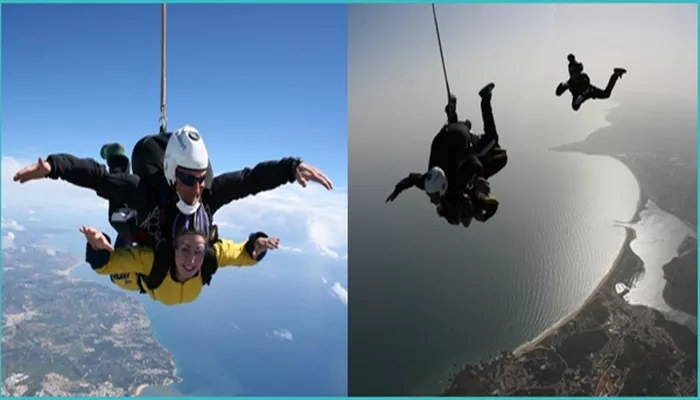Extreme sports have gained immense popularity over the years, with enthusiasts constantly seeking their next adrenaline rush. Among these thrilling activities, skydiving and bungee jumping stand out as two of the most exhilarating options. Both involve jumping from significant heights, but they offer distinct experiences and varying degrees of risk. This article delves into the safety aspects of each sport, exploring which one is more dangerous based on available statistics, safety measures, and personal experiences.
The Basics of Skydiving And Bungee Jumping
Skydiving involves jumping from an aircraft at altitudes typically ranging from 10,000 to 14,000 feet. After freefalling for about 45 seconds, jumpers deploy a parachute to glide safely to the ground. In contrast, bungee jumping entails leaping from a fixed structure, such as a bridge or tower, while being attached to a large elastic cord. The experience is characterized by an immediate drop followed by a rebound effect as the cord stretches and retracts.
Safety Regulations And Training
One of the primary factors influencing the safety of both activities is the level of regulation and training involved.
Skydiving Safety Measures
Skydiving is heavily regulated by organizations like the United States Parachute Association (USPA) and the Federal Aviation Administration (FAA). These organizations set stringent guidelines for training, equipment maintenance, and operational procedures.
Tandem Skydiving: Most first-time jumpers participate in tandem skydives, where they are securely harnessed to a licensed instructor.
This instructor is responsible for all equipment and jump operations.
Equipment: Modern skydiving gear includes multiple safety features:
- A main parachute
- A reserve parachute
An Automatic Activation Device (AAD) that automatically deploys the reserve parachute if the skydiver fails to do so.
Statistics show that in 2022, there were approximately 20 fatal accidents out of 3.9 million jumps, resulting in a fatality rate of about 1 in 195,000 jumps for licensed skydivers. For tandem skydiving specifically, the fatality rate is even lower at 1 in 500,000 jumps over the past decade.
Bungee Jumping Safety Measures
Bungee jumping also has safety regulations but tends to be less regulated than skydiving.
Jump Supervision: While many bungee operators follow strict safety protocols, the level of oversight can vary significantly between locations.
Equipment Risks: Bungee jumping relies primarily on a single elastic cord attached to the jumper. Unlike skydiving, there are no backup systems in place should this cord fail.
Despite these risks, bungee jumping statistics indicate a similar fatality rate to tandem skydiving at about 1 in 500,000 jumps. However, because jumpers are responsible for their own leap without an instructor’s guidance, some people perceive it as riskier.
Psychological Factors And Fear Perception
The perception of danger can vary widely between individuals based on their personal fears and experiences.
Fear of Heights
Interestingly, many people who have a fear of heights often feel more comfortable with skydiving than bungee jumping. This paradox arises because:
In skydiving, jumpers ascend to high altitudes where they cannot see details below them until they jump.
In bungee jumping, participants can see the ground clearly before they leap, which can heighten anxiety about potential failure or injury.
Experience Duration
Skydiving offers a longer experience compared to bungee jumping. The entire process includes:
A climb to altitude (approximately 15 minutes)
A freefall lasting up to 45 seconds
A parachute descent that can take several minutes
Bungee jumps typically last only a few seconds from leap to rebound. This extended duration in skydiving allows participants to enjoy the thrill of freefall while feeling secure due to multiple safety measures.
Comparing Experiences: Which Is More Dangerous?
When evaluating which sport is more dangerous—skydiving or bungee jumping—several factors must be considered:
Statistical Safety: Both activities have similar fatality rates; however, skydiving benefits from more rigorous training and equipment checks.
Backup Systems: Skydiving has multiple layers of safety equipment designed to mitigate risks during freefall. Bungee jumping relies solely on one elastic cord without backup options.
Human Error: Most accidents in both sports are attributed to human error rather than equipment failure. In skydiving, many fatalities involve experienced jumpers making mistakes during complex maneuvers rather than tandem jumps.
Conclusion
Ultimately, both skydiving and bungee jumping provide exhilarating experiences with inherent risks. While statistics suggest that both activities have comparable safety records, skydiving generally offers more robust safety measures due to its regulatory framework and equipment redundancy.
For those considering either sport:
If you prefer a guided experience with multiple safety backups and longer enjoyment time in the air, skydiving may be your best option.
If you seek a quick thrill with fewer regulations and enjoy taking risks alone, then bungee jumping might be more appealing.
Regardless of your choice, understanding the risks involved and preparing adequately will ensure a safer and more enjoyable adventure in either extreme sport.
Related topics:
- Why Is Bungee Jumping An Extreme Sport?
- What Type of Rope Is Used for Bungee Jumping?
- How to Not Be Scared of Bungee Jumping?

